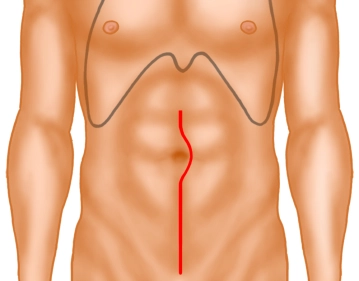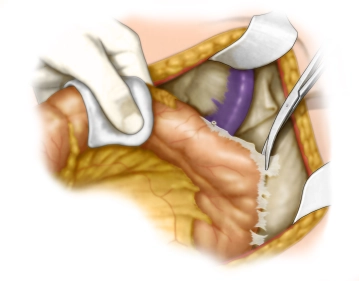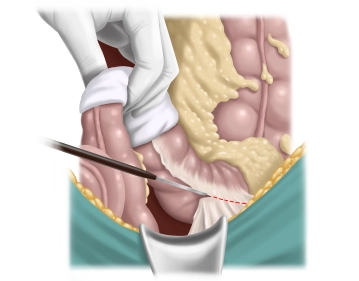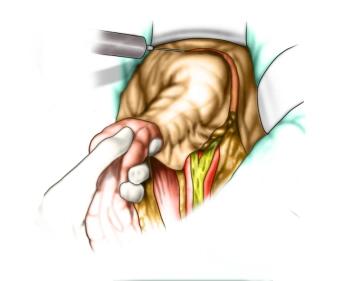Median laparotomy starting at the symphysis and terminating a few centimeters superior to the umbilicus. (It is very important to carry the skin incision down to the symphysis because otherwise this would greatly impair access to the lesser pelvis). If necessary, mobilize the bladder somewhat. Insert a circular wound edge protector followed by a retractor. Intraoperative exploration.
-
Skin incision and exposure
-
Freeing the sigmoid laterally
![Freeing the sigmoid laterally]()
Soundsettings Retract the colon mediad and sharply divide the lateral peritoneal adhesions of the colon with the abdominal wall. Carefully ensure that the preparation is not carried too deeply, i.e., down to the psoas muscle and posterior to the kidney, but that only the mesosigmoid will be mobilized. This will automatically expose the left ureter posteriorly which can then be identified. There is no need to dissect the ureter as in ureterolysis.
-
Freeing the splenic flexure
![Freeing the splenic flexure]()
Soundsettings Mobilize the splenic flexure by alternating between inferiorly dissecting the descending colon off the anterior left kidney in the areolar plane and superiorly by freeing the greater omentum from the transverse colon and entering the lesser sac. As last step divide the links with the spleen.
-
Dividing the inferior mesenteric artery
![Dividing the inferior mesenteric artery]()
Soundsettings Now identify the inferior mesenteric artery by medial incision of the mesosigmoid peritoneum anterior to the aorta. Divide the inferior mesenteric artery with its lymph nodes approximately 1–2cm distal to its origin at the aorta. Primary division of the vessel is indicated apriorion oncologic principles, but studies have not demonstrated any benefit for this. Dividing the artery close to the aorta will prevent injury to the nerve plexus coursing there.
-
Dividing the inferior mesenteric vein
-
Entering the lesser pelvis
Then complete the dissection posteriorly, laterally on the right and finally anteriorly. Keep respe
Activate now and continue learning straight away.
Single Access
Activation of this course for 3 days.
Most popular offer
webop - Savings Flex
Combine our learning modules flexibly and save up to 50%.
US$86.33/ yearly payment
general and visceral surgery
Unlock all courses in this module.
US$172.70 / yearly payment






